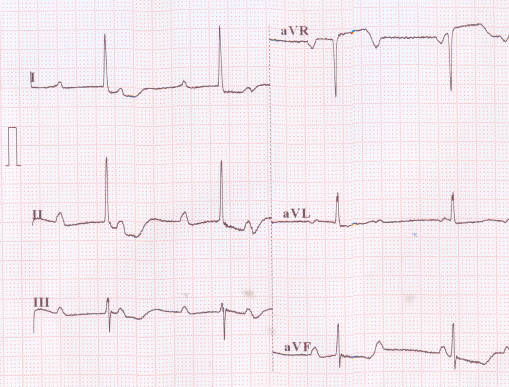Electrocardiographic features of complete heart block
Electrocardiographic features of complete heart block
Brief Review
Abstract: Four criteria for diagnosis of complete heart block on the ECG are constant RR interval, constant PP interval, varying PR interval and PP interval shorter than RR interval.
In complete heart block, the atrial and ventricular rhythms are totally dissociated. The sinus node controls the atrial activity and is evident in the form of regular P waves on the ECG. The ventricular rhythm is controlled either by a junctional rhythm or ventricular rhythm depending on whether the block is supraHisian or infraHisian. Junctional focus will have higher rates and narrow QRS complex while ventricular rhythm will have a lower rate and wide QRS complexes.
As the two rhythms are dissociated, the atrial rate and ventricular rates are different, but regular. Ventricular rate is lower than the atrial rate because the subsidiary pacemaker focus usually has a lower rate than the sinus node. The PR interval is totally varying as the atrial and ventricular rhythms are dissociated and has no relation to each other.
Though the PP intervals and RR intervals are usually regular, there could be some variations occasionally. If there is an occasional conducted beat the ventricular rhythm can show irregularity. Junctional focus can have slight variation in rate due to autonomic influence. Atrial rates can show two types of sinus arrhythmia. In respiratory sinus arrhythmia, PP interval shortens during inspiration as the rate increases and lengthens during expiration as the rate decreases. In ventriculophasic sinus arrhythmia, a PP interval enclosing a QRS complex will be shorter. This is thought to be due to the mechanical effect of ventricular systole causing enhanced pulsation of the sinus node artery penetrating the sinus node.1 It has been shown that the ventriculophasic response can be enhanced by deep inspiration like in the case of sinus arrhythmia.2

Complete heart block – ECG showing the 4 features:
Constant RR and PP intervals, varying PR interval & PP interval < RR interval
Reference
- Dadu RT, McPherson CA. The ventriculophasic response: relationship to sinus arrhythmia and the duration of interposed QRS complexes. Ann Noninvasive Electrocardiol. 2013 Jul;18(4):336-43.
- de Marchena E, Colvin-Adams M, Esnard J, Ridha M, Castellanos A, Myerburg RJ. Ventriculophasic sinus arrhythmia in the orthotopic transplanted heart: mechanism of disease revisited. Int J Cardiol. 2003 Sep;91(1):71-4.